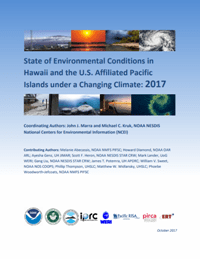State of Environmental Conditions in Hawaii and the U.S. Affiliated Pacific Islands under a Changing Climate: 2017
Report Summary
This report describes the current state of environmental conditions in Hawaii and the U.S. Affiliated Pacific Islands (USAPI) in terms of a set of foundational measures or indicators of change. This information about the trends and patterns in physical, biological, chemical, and ecological observations under a changing climate is intended to facilitate communication among and inform decisions of a broad spectrum of public and private sector stakeholders.
Main Takeaways
Hawaii and the U.S. Affiliated Pacific Islands encompass a vast region comprised of isolated islands that are strategic to U.S. defense and contain global hotspots of marine biodiversity. These islands are exposed to environmental changes that affect every aspect of life.
Discernable trends can be found in global to local measures of greenhouse gas concentrations, surface air temperatures, sea level, sea surface temperature, and ocean acidification. All are rising at an increasing rate. Ocean chlorophyll concentration in surface waters is decreasing.
- Over the last 60 years the concentration of carbon dioxide (CO2) in the atmosphere has increased by about 90 ppm (parts per million), to a value of just over 404 ppm in December of 2016.
- In the Pacific region, land-surface temperatures have been rising at the rate of +0.17°C (0.31°F) per decade since the 1980s, slightly ahead of the global trend. Since 2005, nearly all surface stations have seen annual temperature anomalies above the long-term average.
- Since the early 1990s, global mean sea level (GMSL) has been rising at a rate of about 3.3 mm (0.13 in) per year. Sea level has also been rising across the region, from as low as 1.1 mm (0.43 in) per year at the Honolulu tide gauge to as high as 5.4 mm (0.21 in) per year at the Kwajalein tide gauge since the early 1990s. However, regional and local sea level trends may differ significantly from the globally averaged rate over multiyear to multidecadal time scales.
- Globally averaged sea surface temperature (SST) increased by about 1.0°C (1.8°F) over the past 100 years. Half of this rise has occurred since the early 1990s. Regionally averaged SST trends follow the globally averaged trend. Over the last 5 years almost the entire tropical Pacific and in particular areas along the equator have seen temperatures warmer than the average over the last 30 years.
- Globally, aragonite saturation state (a proxy for ocean acidity) has decreased at a rate of −0.03 per decade over the last 200+ years. More recent rates of change in aragonite saturation state, on the order of −0.13 per decade, are reported for the Pacific Ocean.
- In all major mid-ocean subtropical gyres there has been an expansion of areas with low chlorophyll concentration (low biological productivity) since 1998. During the 9-year period 1998–2006, low productivity areas within the North Pacific subtropical gyre grew by 2.2% per year.
Trends in measures of rainfall, surface winds, and tropical cyclones are not as readily apparent. Patterns of climate variability characterize these measures, and tend to mask long-term trends. Exceptions are consistent increases in the number of days with heavy precipitation and subregional changes in the number of days with high winds.
- Precipitation patterns are highly regionalized, often with local variations in those
regions. Average annual rainfall amounts over the last 50 years indicate that western Micronesia is getting wetter while eastern Micronesia is trending drier. Hawaii and parts of the Central Pacific are also drying out, but rainfall amounts are gradually increasing in the central south Pacific, an area that includes American Samoa. - The global frequency of tropical cyclones (TCs) appears to be showing a slow downward trend since the early 1970s. In the Pacific region long-term TC trends in frequency and intensity are relatively flat, with the record punctuated by as many active as inactive years.
Changes in the magnitude of particular indicators may be small, but these small changes in magnitude can translate to large changes in frequency.
- At the tide gauge at Kwajalein, high water events that occurred less than once a year, on average, in the 1960s occurred 22 times a year, on average, during the decade staring in 2005.
- For American Samoa and Samoa the number of days per year with a Degree Heating Week (DHW) value reaching at least 1°C-week has increased has increased from 8 days during the first 10 years of the record to frequently more than 50 days during the last 10 years of the record.
Lack of high quality, long-term observational records, particularly with respect to in situ stations, contributes to difficulties in discerning trends. To maintain and enhance our ability to assess environmental change, attention needs to be given to robust and sustained monitoring.

